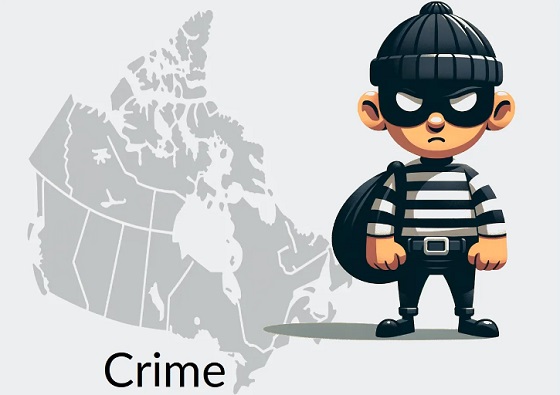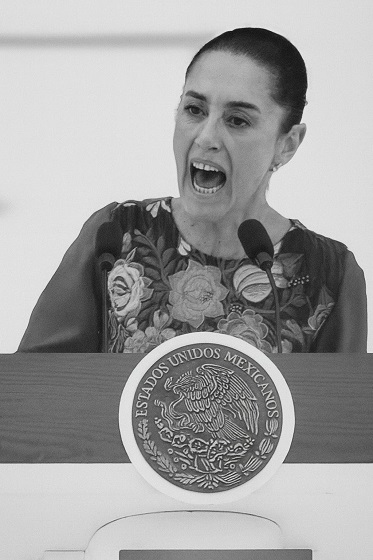Crime
Has Canada’s Criminal Code Lost Its Way?

From The Audit
I am neither a lawyer nor the son of a lawyer and, thankfully, I’ve never been dragged through the justice system as a participant. But that doesn’t mean I can’t have thoughts.
My recent post on auto theft conviction rates ended with a suggestion that the size and complexity of Canada’s Criminal Code might be contributing to systemic problems with our courts – including suffocating inefficiencies. I’d like to explore that idea a bit more here.
First of all though, complexity is not the driver of most criminal behavior. You don’t need a law degree to know that you shouldn’t steal someone’s car or break his nose in a barroom brawl. And anyone with a grade three education should realize that government program fraud isn’t exactly saintly behaviour.
But overly complex laws can be responsible for some serious problems. Consider how clarity is actually a cornerstone of justice. In Canada, for instance, the Void for Vagueness Doctrine holds that a law is invalid if it’s too vague for the average person to understand. That’s because such laws fail to provide “fair notice” of what’s prohibited and clear standards for enforcement.
Similarly, if accused criminals can demonstrate that the complexity or ambiguity of the statute led them to reasonably believe their conduct was lawful, those laws might fail the necessary mens rea requirement for certain offences.
Unfortunate illustrations of this problem make appearances in some recent Liberal government legislation:
- Online Harms Act (Bill C-63) fails to provide a clear definition for “online harm”. This makes it impossible for citizens to anticipate how the new Digital Safety Commission will enforce the law.
- Online Streaming Act (Bill C-11) appears to require streaming services (like YouTube) to regulate user-generated content using an undefined standard.
- Online News Act (Bill C-18) could affect how news is shared and accessed online, potentially influencing the availability and distribution of Canadian news.
Of those, at least C-63 and C-11 – in their current form – could expose individuals to significant criminal and civil penalties without providing clarifying details.
Here’s another example. Section 423 of the Criminal Code prohibits intimidation:
423(1) Every one is guilty of an indictable offence and liable to imprisonment for a term of not more than five years or is guilty of an offence punishable on summary conviction who, wrongfully and without lawful authority, for the purpose of compelling another person to abstain from doing anything that he or she has a lawful right to do, or to do anything that he or she has a lawful right to abstain from doing…blocks or obstructs a highway.
And Section 430 prohibits “mischief”, whose definition includes:
interfering with the lawful use, enjoyment, or operation of property.
Just playfully attaching a sticker to someone’s car could lead to charges even if there was no intent to cause harm (by, say, damaging the car’s paint).
The problem here is that both Sections 423 and 430 are, to put it mildly, inconsistently enforced. This is something I’ve already discussed in my Limits of Legal Protest post. Participants in recent pro-Hamas protests flagrantly blocked lawful access to roads, parks, and public buildings for weeks at a time in cities across the country. That’s a clear Section 423 and 430 violation. And yet, of the many hundreds of participants, only a handful were ever arrested and, to my knowledge, none was charged with mischief or intimidation.
Now I know exactly what you’re thinking: “Come on Clinton, what about 430(7)?”
No person commits mischief within the meaning of this section by reason only that he attends at or near or approaches a dwelling-house or place for the purpose only of obtaining or communicating information.
Weren’t those protesters just there to communicate information (“from the river to the sea…”)? Well I’m actually not sure how much meaningful communication was happening at those gatherings. Dialog didn’t seem to be their primary focus. But the legal issue wasn’t where they chose to stand, it was the fact that they actively and intentionally prevented the lawful use, enjoyment, or operation of property – both private and public.
Now, in that context, is it reasonable to prosecute any acts of mischief or intimidation anywhere in Canada? Couldn’t a person reasonably argue that he was under the informed opinion that Canadian police largely ignored such offences?
As the Criminal Code grows, its internal complexity is bound to increase along with it. Comparing the PDF version of the June 15, 2011 version of the Code (1,025 pages) to the most recent version (1,349 pages) gives us a sense of the changes that are happening in both government and society as a whole. More than 226,000 words (in both French and English) were added over that time, a 31 percent increase. Revisions included updates concerning firearms and weapons, remote proceedings, indigenous rights, organized crime and terrorism, and palliative care.
All that’s not necessarily a bad thing. But when poorly-written legislation (like C-11) makes it into the books and perfectly fine legislation (like Section 430) is enforced unevenly, then we’re asking for trouble. A competent government should be able to do better than that.
Crime
B.C.’s First Money-Laundering Sentence in a Decade Exposes Gaps in Global Hub for Chinese Drug Cash

Port Coquitlam Mayor Brad West met with Biden Secretary of State Antony Blinken in 2023, to discuss Canada’s enforcement gap on fentanyl money laundering.
Chinese underground-banking conviction is a baby step in a jurisdiction that some experts see as North America’s center of gravity for transnational crime.
In a milestone that is staggering for its rarity in a jurisdiction regarded as a global nexus of Chinese transnational money laundering that facilitates fentanyl trafficking for Mexican and Iranian gangs, British Columbia’s anti-gang unit has finally secured its first money laundering sentencing in a decade.
On Monday, a B.C. Supreme Court judge sentenced 37-year-old Richmond resident Alexandra Joie Chow to 18 months in jail for laundering the proceeds of crime, following a six-year investigation that targeted illegal Chinese underground casinos and unlicensed money transfer businesses in Metro Vancouver. The court also ordered the forfeiture of cash and bank drafts seized during the probe, the Combined Forces Special Enforcement Unit of B.C. (CFSEU) says.
Chow’s case marks the first time in roughly ten years that a money-laundering investigation in British Columbia has actually resulted in a sentencing — a remarkable data point in a province where hundreds of billions have washed through casinos, banks and real estate, according to The Bureau’s estimates, yet almost no one has been successfully prosecuted for the underlying financial crime.
While Chow’s case in itself is relatively small in dollar terms, it followed the catastrophic collapse of the RCMP’s E-Pirate probe into a Richmond underground bank called Silver International, which was alleged to have laundered over $1 billion through a network of Chinese Triad leaders known as “Sam Gor” or “The Company” — a scheme that moved drug cash collected in Chinese diasporas across North and Latin America, cycling the funds back to hundreds of accounts in China, in part through lending gang cash to Asian high-rollers who washed massive sums through B.C. government casinos.
The collapse of E-Pirate raised significant concerns in Washington around Canada’s capacity to prosecute fentanyl money laundering and trafficking. Vancouver-area Mayor Brad West has told The Bureau that the failure of Canadian authorities to secure convictions in that case was explicitly noted in 2023 by senior figures in the Biden administration, including Secretary of State Antony Blinken, in discussions about Canada’s role in North American drug trafficking.
Chow pleaded guilty in February 2025 to one count of laundering proceeds of crime after prosecutors alleged she was part of an underground loan-sharking and money-services scheme that operated in the Lower Mainland. Her plea came almost two years after B.C.’s Joint Illegal Gaming Investigation Team first announced charges.
The trail to that conviction began in August 2019, when B.C.’s Joint Illegal Gaming Investigation Team (JIGIT) quietly launched an investigation into the alleged loan-sharking and money-laundering activities of a man and a woman. Investigators believed the suspects were charging criminal interest rates and operating an unlicensed money services business.
Over the course of the probe, police say they developed evidence that the suspects allegedly laundered more than $828,000 in Canadian cash. On November 5, 2021, JIGIT executed a series of search warrants on properties in Richmond and Burnaby, as well as three vehicles associated to the investigation.
The searches resulted in the seizure of a number of items believed to be tied to money laundering and loan-sharking, including score sheets with client names and payment due dates, four cellular phones, two bank drafts totaling $50,000, and $10,680 in Canadian currency and three high-end vehicles.
Two years later, on November 1, 2023, the B.C. Prosecution Service approved four sets of charges against Chow: money laundering, possessing proceeds of crime, and entering into agreements to receive criminal-rate interest — classic loan-sharking. No other individuals were ultimately charged in the case.
As CFSEU-BC media officer Sgt. Sarbjit Sangha put it in the unit’s statement Monday, this is “the first time in a decade that a money laundering investigation in British Columbia has resulted in a sentencing,” and it “underscores the impact of collaborative investigative work” and JIGIT’s mandate to tackle illegal gaming tied to organized crime, loan-sharking and sophisticated bookmaking.
The scale of the enforcement gap this case exposes is critical to understanding current irritants between Washington and Ottawa, and the Trump administration’s leverage of tariffs on Canada. That campaign of economic pressure, some U.S. and Canadian officials have informed The Bureau, apparently extends from deep concerns in both the Biden and Trump administrations over Ottawa’s lack of meaningful action against massive money laundering through Canada’s financial system — including the TD Bank fentanyl money laundering case prosecuted in the Tri-State area, which exposed transactions similar to those revealed in the Chow investigation in Richmond.
The Cullen Commission into money laundering in B.C. found that by 2014, casinos in the province were accepting nearly $1.2 billion in cash transactions of $10,000 or more in a single year, many involving patrons who showed classic indicators of criminal cash — bricks of small bills delivered in bags by couriers closely watched by organized-crime investigators. JIGIT itself was created as part of the province’s response to that crisis. In a 2021 presentation to the Cullen Commission, then-Unit Commander Staff Sgt. Joel Hussey explained that JIGIT’s money-laundering and loan-sharking probes were focused on “top-tier” organized criminals exploiting casinos and banks, particularly at Richmond’s River Rock Casino Resort, Vancouver’s Parq Casino and Burnaby’s Grand Villa, where investigators saw the most entrenched high-roller criminal activity.
Yet the province’s record in actually getting such cases to the finish line has been abysmal. The most notorious example remains E-Pirate, the massive RCMP investigation that targeted Silver International, a Richmond underground bank alleged to be moving over $1 billion a year in drug and casino cash for Chinese and Mexican cartels and Middle Eastern networks. That case collapsed in 2018–2019 after federal prosecutors mistakenly exposed a confidential informant, leading to a stay of charges despite years of work and huge evidence seizures.
International bodies such as the Financial Action Task Force later used E-Pirate as a case study, describing a “professional” Richmond-hub laundering network that allegedly used B.C. casinos and real estate to clean and move drug proceeds on a global scale. Cullen’s final report, released in 2022, concluded that sophisticated money-laundering networks were moving “staggering amounts” of illicit funds through B.C., while law-enforcement and regulatory agencies failed to respond in a timely or coordinated way.
Whether Chow’s 18-month sentence becomes a template for future Vancouver Model prosecutions — or remains an isolated success in a province still struggling to hold money launderers to account — will be the next test for B.C.’s anti-gang and financial-crime enforcement regime.
Those questions are not just academic in Ottawa. As The Bureau has previously reported, senior officials in Washington — Democrats and Republicans alike — have for years warned that Canada’s failure to deliver sustained proceeds-of-crime prosecutions, and its lack of a RICO-style racketeering law, has turned the country into a structural weak point in North America’s fight against cartel-linked fentanyl networks.
As reported previously by The Bureau, in a high-level meeting in 2023, according to Vancouver-area Mayor Brad West, a longstanding critic of transnational drug networks in his province, Secretary of State Antony Blinken stressed that Washington believes Beijing is effectively weaponizing fentanyl against North Americans—and that Canada stands out as a worrisome weak link in the global supply chain.
West, reflecting on his encounter with Blinken, argued that only bold legislative change, coupled with a willingness to challenge entrenched legal barriers, can dispel the U.S. government’s unease over Canada’s approach. “Secretary Blinken specifically noted the lack of a RICO-style law in Canada,” West said. “He talked about how, in the United States, that law had been used to take down large portions of the mafia. Then he looked at us—one of America’s closest allies—and saw a very concerning weak link.”
According to West, Blinken pointed to China’s role in funneling precursor chemicals into fentanyl labs. He warned that China’s government, if inclined, could stem the flow but has little interest in doing so. “He was incredibly candid,” West recalled. “He confirmed the connection between the Chinese Communist Party, the triads, and the Mexican cartels, telling me these groups are working together—and it’s Canada where they’re finding a safe operating base.”
Blinken also conveyed to West that U.S. agencies had grown hesitant to share certain intelligence with their Canadian counterparts. “He told me that U.S. intelligence and law enforcement are withholding some evidence because they don’t believe we’ll act on it,” West explained. “They’ve lost confidence.”
West added that in ongoing communications, he had learned American officials are shocked that major figures in Asian organized crime “seem to have so much access to our political class. They’re basically saying, ‘What’s going on in Canada?’”
A major concern, according to West, is how known criminals manage to appear at political events or fundraisers with little oversight. “It’s not necessarily that politicians are complicit, but our political structures have weak guardrails,” West said. “The Americans see pictures of transnational criminals mingling at official gatherings and find it baffling.”
The Bureau is a reader-supported publication.
To receive new posts and support my work, consider becoming a free or paid subscriber.
Crime
Mexico’s Constitutional Crisis

Civitatensis
This is the situation Mexico faces today, but Mexico is hardly unique in confronting the challenge of criminal governance displacing state authority. Colombia spent decades battling FARC and cartel control over vast territories before slowly, painfully reclaiming sovereignty through a combination of military force and institution-building. Sicily lived under Mafia governance so complete that the Italian state effectively ceased to exist in many regions until the maxiprocesso trials of the 1980s demonstrated that the state could, if it chose, reassert authority. Afghanistan never successfully resolved the tension between state and warlord governance, leaving a vacuum that extremist organizations repeatedly exploited. Even the United States faced similar dynamics during Prohibition, when organized crime achieved such power that it effectively governed cities like Chicago and controlled elected officials at every level.
What distinguishes these cases from ordinary high-crime environments is the transition from criminal activity within a state to criminal governance replacing the state. When armed organizations collect taxes, regulate economic activity, administer their own justice, and determine who holds political office, they have become the de facto government regardless of constitutional fictions to the contrary. The question for any state facing this challenge is brutally simple: will it fight to restore its monopoly on legitimate violence, or will it accommodate the new reality through various forms of negotiated coexistence?
Colombia chose to fight, deploying military force under Plan Colombia while building investigative and prosecutorial capacity. The strategy took decades, cost thousands of lives, and required uncomfortable partnership with the United States. It also worked, transforming Colombia from a failing state into one of Latin America’s most dynamic economies. Sicily’s anti-Mafia campaign similarly required accepting that normal law enforcement had failed, that extraordinary measures (including aggressive use of military resources and suspension of certain procedural protections) were necessary, and that restoration of state authority was the prerequisite for everything else Italians valued about constitutional governance. Afghanistan never made that choice, instead attempting to negotiate with warlords and incorporate them into formal governance structures. The result was permanent instability and eventual state collapse.
The implications extend far beyond Mexico’s borders. Guatemala faces similar challenges with criminal organizations controlling substantial territory. El Salvador’s Nayib Bukele deployed extraordinary measures (mass arrests, suspension of certain rights) to break gang control, producing dramatic violence reductions that other states in the region are studying closely. Brazil’s favelas demonstrate how criminal governance can persist for generations within otherwise functional states when authorities accept de facto partition of sovereignty. And the United States watches nervously as fentanyl flows across a border it shares with a neighbor whose government may lack the capacity or will to control its own territory.
The Mexican case matters because Mexico is not a failed state in the traditional sense. It has functional institutions, a growing economy with healthy foreign investment, democratic elections, and sophisticated political culture. Yet armed criminal organizations control substantial portions of its territory and operate with such impunity that they assassinate elected officials while the national government insists it cannot respond forcefully because doing so would violate constitutional norms. If Mexico cannot resolve this tension between constitutional formalism and effective sovereignty, what hope exists for weaker states facing similar challenges?
On November 5, 2025, Mexican President Claudia Sheinbaum stood before reporters at the National Palace and declared: “Regresar a la guerra contra el narco no es opción” (returning to the war against the narcos is not an option). The statement came in the wake of the assassination of Carlos Manzo, the mayor of Uruapan, Michoacán. It came as reports surfaced that the Trump administration was considering military operations against cartel infrastructure on Mexican soil. And it came as Mexico’s homicide rate continued to run at more than four times the threshold epidemiologists use to define a violence epidemic.
Sheinbaum’s position deserves serious engagement. She’s not wrong that Felipe Calderón’s 2006-2012 “war on drugs” produced catastrophic violence. She’s not wrong that militarized approaches lacking proper legal frameworks can violate constitutional rights. And she’s not wrong that sustainable security requires addressing “root causes,” not just symptoms.
She is, however, catastrophically wrong about the choice before Mexico. And her wrongness stems from a fatal confusion about constitutional order.
Mexico doesn’t have a crime problem. It has a sovereignty problem. In substantial portions of Mexican territory, the state does not govern. Criminal organizations do. They collect taxes through extortion. They administer justice through execution. They regulate economic activity through control of drug production, human trafficking, and legitimate businesses. They determine who holds political office through assassination.
The numbers tell part of the story. Mexico experienced over 190,000 homicides during the six-year term of Andrés Manuel López Obrador, Sheinbaum’s predecessor and political mentor. The country’s murder rate stands at approximately 24 per 100,000 inhabitants. The World Health Organization considers death rates above 5.8 per 100,000 to constitute an epidemic. Mexico has sustained epidemic-level violence for nearly two decades.
But raw numbers understate the constitutional crisis. In Sinaloa, a cartel war produced 150 homicides in a single month following the capture of “El Mayo” Zambada. In Guanajuato, despite billions in foreign investment from companies like GM and Mazda, the state recorded over 3,000 murders in 2023 alone. In Michoacán, mayors serve at cartel pleasure. Those who displease them, like Carlos Manzo, are killed despite state security protection.
This is not “high crime.” It is contested sovereignty. And it demands one asks: what is a constitutional order? What is a constitution for when armed groups, not legitimate governments, determine who lives, dies, and governs?
To her credit, Sheinbaum hasn’t dismissed security concerns. She’s articulated a principled constitutional objection to militarized approaches that merits some consideration. Her core legal argument runs like this: The “war against the narcos” that Felipe Calderón declared in December 2006 was “fuera de la ley” (outside the law) because it amounted to “permiso para matar, sin ningún juicio” (permission to kill without any trial). When the state operates under a “war” framework rather than a law enforcement framework, it abandons the due process guarantees that constitute the bedrock of constitutional governance.
Mexican constitutional law, like that of most democracies, distinguishes sharply between policing and warfare. Police operate under criminal procedure codes. They make arrests. They gather evidence. They bring charges. Suspects receive trials. This framework protects the innocent and the guilty from arbitrary state violence. Military operations, by contrast, operate under rules of engagement typically designed for armed conflict with foreign enemies. The objective is to defeat or eliminate the enemy, not to arrest and prosecute them. When Calderón appeared in military uniform to declare war on the cartels, he was replacing constitutional law enforcement with unconstitutional military operations against Mexican citizens.
The empirical record supports Sheinbaum’s concern about outcomes. Calderón’s six-year term saw intentional homicides increase by 148%. The militarization occurred “sin marco jurídico” (without legal framework), producing extrajudicial executions and systematic human rights violations. Rather than defeating the cartels, the offensive fragmented them, creating dozens of smaller, more violent organizations fighting over territory.
Sheinbaum characterizes calls to return to this approach as “autoritarios, es ir hacia el fascismo, donde no hay estado de derecho y donde todo es extrajudicial” (authoritarian, going toward fascism, where there is no rule of law and where everything is extrajudicial). Once you declare “war” on your own citizens, even criminal ones, you’ve abandoned the fundamental premise that the state’s monopoly on force must operate through law, not above it.
Her alternative strategy, as far as one can see, rests on four pillars: prevention through social programs, intelligence-led investigation, coordination between government levels, and consolidation of the National Guard. Rather than “permission to kill,” her approach promises to “atender las causas” (address the causes) of violence while respecting human rights and constitutional constraints. She even invokes sovereignty, rejecting U.S. offers of deeper cooperation: “Aceptamos la ayuda en información, en inteligencia; pero la intervención, no” (We accept help with information and intelligence, but intervention, no). Mexico, she insists, is a sovereign nation that will solve its problems through constitutional means.
This is a serious position, grounded in genuine constitutional concerns and supported by real evidence of past failures. It deserves better than dismissive responses about being “soft on crime.” It also deserves to be demolished, because it represents constitutional formalism untethered from constitutional purpose.
The problem with Sheinbaum’s argument is that it suffers from a catastrophic inversion of constitutional hierarchy. She treats procedural rights as the foundation of constitutional order when they are the product of constitutional order. Constitutions don’t exist to guarantee procedural arrests and trials. They exist to secure the conditions under which civilized life (including trials) becomes possible. Those conditions require that the state, not armed criminal bands, exercise a monopoly on legitimate violence within its territory. When that legitimate monopoly collapses, the constitutional order has already failed. Insisting on procedural niceties while armed groups govern entire regions isn’t defending a constitution. It’s presiding over its irrelevance.
Consider Sheinbaum’s claim that using military force against cartels constitutes “permission to kill without trial.” This framing would be apt if the cartels were ordinary criminal suspects who could be arrested, charged, and tried. But that’s not what cartels are. Cartels are para-military insurgent organizations that control territory, maintain armed forces, collect taxes, and administer parallel governance. Force and murder are their currency. When cartel soldiers operate checkpoints, when they regulate who can do business in “their” territory, when they execute those who disobey “their” laws, they’re not committing crimes. They’re exercising extra governmental authority.
No one demands that lawful police obtain arrest warrants before returning fire against active shooters. When armed groups engage in sustained territorial control and firefights with security forces, responding with military force isn’t “extrajudicial execution.” It’s the state exercising its foundational obligation to maintain a monopoly on legitimate violence. Sheinbaum’s proceduralism would make perfect sense in a functioning state where criminals operate as individuals within a legal order they cannot overthrow. It makes no sense when armed organizations have already overthrown that legal order in substantial territories. One cannot guarantee due process to people living under cartel governance because cartels don’t recognize due process. The state’s obligation is to restore the conditions under which due process can function.
The empirical claims supporting Sheinbaum’s position also require scrutiny rather than acceptance. She points to declining homicide statistics as evidence her approach works. The government claims a 37% reduction in the daily homicide rate between September 2024 and October 2025. But this statistic conceals more than it reveals. Disappearances rose by 20% during the same period. Bodies never found don’t appear in homicide statistics, creating a perverse incentive for cartels to disappear victims rather than leave corpses. Using homicide data to measure security when disappearances are rising is like measuring flood damage by counting only the houses you can still see.
Even accepting the government’s numbers at face value, Mexico remains mired in catastrophic violence. Celebrating a decline from apocalyptic to merely catastrophic violence while cartels control substantial territory is like a cancer patient celebrating that their tumor is growing more slowly. Sheinbaum’s historical narrative blames Calderón’s confrontation for causing violence while ignoring the counterfactual. The cartels were already growing in power and territorial control before 2006. Calderón confronted them; his successors accommodated them. Violence during confrontation doesn’t prove that accommodation would have prevented it. The violence might simply have taken different forms (slower-burning, less visible, but equally devastating) as cartels consolidated control.
The Sheinbaum-López Obrador approach has now governed Mexico for seven years. The result? Mexico’s violence remains at epidemic levels. Cartels control more territory than before. State officials continue to be assassinated. And the government’s response is to insist that their approach is working because things aren’t getting worse as quickly. This is the logic of managed decline dressed up as policy success.
The contradiction becomes most apparent when examining Sheinbaum’s invocation of sovereignty. She rejects U.S. assistance beyond intelligence sharing, proclaiming that Mexico is “un país soberano e independiente” (a sovereign and independent nation). But sovereignty doesn’t mean the absence of foreign forces on your territory. It means the state, not competing armed groups, exercises legitimate authority over territory. When cartels control checkpoints, collect taxes, administer justice, and determine who can hold office, they are the sovereign. Mexico has not lost sovereignty to potential U.S. intervention. It has already lost sovereignty to the cartels in substantial portions of its territory.
Sheinbaum’s position amounts to: “We will defend Mexican sovereignty by ensuring that Mexican criminal organizations, rather than the Mexican state, govern Mexican territory.” This isn’t nationalism. It’s surrender with flags.
Her emphasis on “addressing root causes” through social programs like Jóvenes Construyendo el Futuro (Youth Building the Future) reflects a similar misunderstanding of the challenge Mexico faces. Social programs make sense for preventing the next generation from joining cartels. They do nothing about the current generation of cartel soldiers already controlling territory, extracting wealth, and terrorizing populations. When your house is burning, you don’t address the root causes of combustion. You extinguish the fire. Once it’s out, you can investigate electrical wiring.
The poverty-causation theory is also empirically weak. Many poor regions of Mexico have low violence. Many cartel strongholds aren’t the poorest areas. Guanajuato, with billions in foreign investment, leads the nation in murders. The cartels aren’t driven by poverty. They’re multi-billion dollar enterprises driven by American demand for drugs. No job training program addresses that economic engine. More fundamentally, “addressing root causes” during an active insurgency confuses peacetime governance with wartime emergency. It’s the logic of a government that has already accepted permanent cartel sovereignty and now seeks merely to manage its fraying consequences.
The legal framework objection reveals similar evasion. Sheinbaum argues that Calderón’s approach lacked proper legal framework. Fine. Then create one. The Mexican Congress is controlled by Morena, Sheinbaum’s party. If the problem with military operations against cartels is the absence of legal framework, the solution is obvious: pass legislation explicitly authorizing such operations with clear rules of engagement, judicial oversight, accountability mechanisms, and defined criteria for when military force is appropriate.
But Sheinbaum doesn’t propose this. Her argument amounts to: “We can’t use force because there’s no legal framework, and we won’t create a legal framework because we oppose using force.” This is circular reasoning designed to avoid a hard choice, not a principled constitutional position. The reality is that every constitutional democracy maintains legal frameworks for deploying military force in extraordinary circumstances. The question isn’t whether such frameworks can exist consistent with constitutional governance (they manifestly can). The question is whether Mexico’s government has the will to create and use them. Sheinbaum’s answer appears to be no, which means her constitutional objections are pretexts, not principles.
Strip away the constitutional theory and what remains is a simple moral question: Does the Mexican government owe its citizens protection from cartel violence? Citizens in cartel-controlled regions live under constant extortion. They cannot conduct business freely. They face arbitrary violence with no recourse to justice. They cannot choose their leaders, who face assassination if they displease cartel bosses. These aren’t abstract harms. They’re daily realities for millions of Mexicans.
When Sheinbaum declares that military action would be “authoritarian” or “fascist,” she ignores that these citizens already live under murderous authoritarianism and fascism, administered by cartels, not the state. Her refusal to deploy state power to protect them doesn’t defend their rights. It abandons them to vile predation. The government’s response to the Uruapan mayor’s assassination is revealing. Despite having security protection (one bodyguard even killed an attacker), Carlos Manzo was murdered. The state cannot protect its own officials. Yet Sheinbaum’s reaction is not to strengthen state capacity but to reject calls for stronger action as illegitimate.
Citizens in Michoacán protested, expressing understandable “indignación por lo ocurrido” (indignation at what happened). Sheinbaum’s response? She questioned whether protest convocations were “legitimate,” suggesting they were politically motivated by opposition forces. This is the posture of a government that has accepted cartel sovereignty as immutable reality and now treats citizens demanding protection as the problem.
The purpose of government is not to guarantee trials. It’s to secure the conditions under which civilized life becomes possible. Those conditions require that the state maintain a monopoly on legitimate violence. When armed groups seize territory, the state’s first obligation is to restore its monopoly on force. Not because violence is good, but because it’s the prerequisite for everything else we value. You cannot have economic development while businesses pay extortion. You cannot have democratic governance while officials face assassination. You cannot have justice while cartels administer their own law.
Sheinbaum’s approach defends the form of constitutional governance while surrendering its substance. It’s constitutional suicide masked as principle. The alternative is a properly designed legal framework for deploying overwhelming state force to restore territorial control, followed by institution-building to maintain it. This would involve clear legislative authorization for military operations against armed groups controlling territory, rules of engagement that distinguish between legitimate use of force and extrajudicial killing, judicial oversight to ensure accountability, coordination with competent international partners (the U.S., obviously, but not exclusively), massive investment in investigative capacity and prosecutorial infrastructure, and once territorial control is restored, social programs and economic development to prevent recurrence.
The current approach guarantees only one thing: continued cartel sovereignty over substantial Mexican territory, and continued abandonment of millions of citizens to predation.
The lessons extend beyond Mexico. Other Latin American states watch carefully as Mexico demonstrates what happens when governments prioritize procedural correctness over effective sovereignty. Guatemala faces similar cartel penetration and must decide whether to follow Mexico’s accommodation or chart a different course. Brazil’s approach to favela governance shows how partition of sovereignty can become permanent if accepted for too long. Even wealthy democracies face versions of this challenge when criminal organizations achieve sufficient power that normal law enforcement proves inadequate.
The question isn’t unique to developing states or regions with weak institutions. It’s a central feature of political life. The rule of law depends on someone willing to enforce it. Once the state declines that obligation, it cedes the field to those who recognize no law but power. That’s not constitutional governance. It’s surrender.
|
|||||
|
|||||
| Select writings and discussions on regional politics and culture in Latin America |
-

 Agriculture2 days ago
Agriculture2 days agoHealth Canada indefinitely pauses plan to sell unlabeled cloned meat after massive public backlash
-

 Energy16 hours ago
Energy16 hours agoPoilievre says West Coast Pipeline MOU is no guarantee
-

 Carbon Tax19 hours ago
Carbon Tax19 hours agoCanadian energy policies undermine a century of North American integration
-

 Alberta16 hours ago
Alberta16 hours agoWest Coast Pipeline MOU: A good first step, but project dead on arrival without Eby’s assent
-

 Energy15 hours ago
Energy15 hours agoWill the New West Coast Pipeline MoU Lead to Results? Almost Certainly Not According to AI
-

 Alberta14 hours ago
Alberta14 hours agoCarney forces Alberta to pay a steep price for the West Coast Pipeline MOU
-

 Alberta18 hours ago
Alberta18 hours agoAlberta and Ottawa ink landmark energy agreement
-

 Crime2 days ago
Crime2 days agoFBI Seizes $13-Million Mercedes Unicorn From Ryan Wedding’s Narco Network









